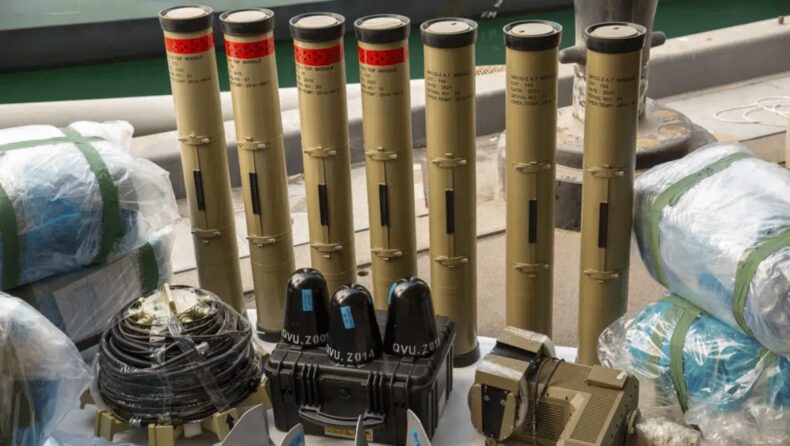Table of Contents
British navy seizes Iranian missiles: parts likely for Yemen,authorities said Thursday, the latest such seizure in the Gulf
On February 23, 2024, the Royal Navy intercepted a boat in the Gulf of Oman carrying anti-tank missiles and fins for ballistic missile assemblies that were likely destined for Yemen’s Houthi rebels. The seizure took place after a US aircraft detected the small motorboat with cargo covered by a grey tarp heading from Iran. The Royal Navy frigate HMS Lancaster gave chase to the vessel, which then attempted to re-enter Iranian territorial waters but was stopped before it could.
British navy seizes Iranian missiles
The British troops discovered Russian 9M133 Kornet anti-tank guided missiles, known in Iran as “Dehlavieh,” as well as small fins identified as jet vanes for medium-range ballistic missiles. Both of these weapons have been seen in previous seizures suspected to be from Iran and bound for Yemen.
The seizure is significant as it highlights the increasing pressure being placed on Iran by Western powers, who have long accused the Islamic Republic of arming the Houthis, in violation of a United Nations resolution banning arms transfers to the group. Iran has denied these allegations, despite widespread evidence and numerous seizures of weapons tied back to Iran. In recent years, the international community has increasingly sought to hold Iran accountable for its actions and prevent the proliferation of weapons in the region.

The discovery of these weapons is also a reminder of the urgent need to find a peaceful resolution to the ongoing conflict in Yemen. The war in Yemen has been ongoing since 2014, when the Houthi rebels took control of the country’s capital, Sana’a, and led an insurgency against the internationally recognized government. The conflict has since escalated into a devastating humanitarian crisis, with millions of people facing starvation, disease, and displacement. The United Nations estimates that around 23.4 million people in Yemen require assistance, including almost 13 million children.
While Saudi-led airstrikes have not been recorded in Yemen since the kingdom began a ceasefire in March 2022, the ceasefire expired in October, raising concerns that the war could once again escalate. The international community has been working to renew the ceasefire and negotiate a peaceful resolution to the conflict, but progress has been slow. The seizure of these weapons further complicates the situation, as it is likely to increase tensions between Iran and Western powers, as well as between the various factions involved in the Yemeni conflict.
likely for Yemen
Iranian state media did not immediately acknowledge the seizure, and the country’s mission to the United Nations did not respond to a request for comment. The US Navy described the seizure as occurring “along a route historically used to traffic weapons unlawfully to Yemen.” Vice Adm. Brad Cooper, the commander of the American 5th Fleet, said that this was the “seventh illegal weapon or drug interdiction in the last three months and yet another example of Iran’s increasing malign maritime activity across the region.”
The seizure is also significant in light of Iran’s recent decision to enrich uranium closer than ever to weapons-grade levels. This move has raised concerns among the international community about Iran’s intentions and has led to increased scrutiny of the country’s actions. The discovery of these weapons is likely to further fuel concerns about Iran’s role in the region and its potential to destabilize the area. This raid sheds light on the vitality of international cooperation in preventing arms trade and enforcing UN resolutions, particularly in areas of the world where conflict and instability are prevalent.













